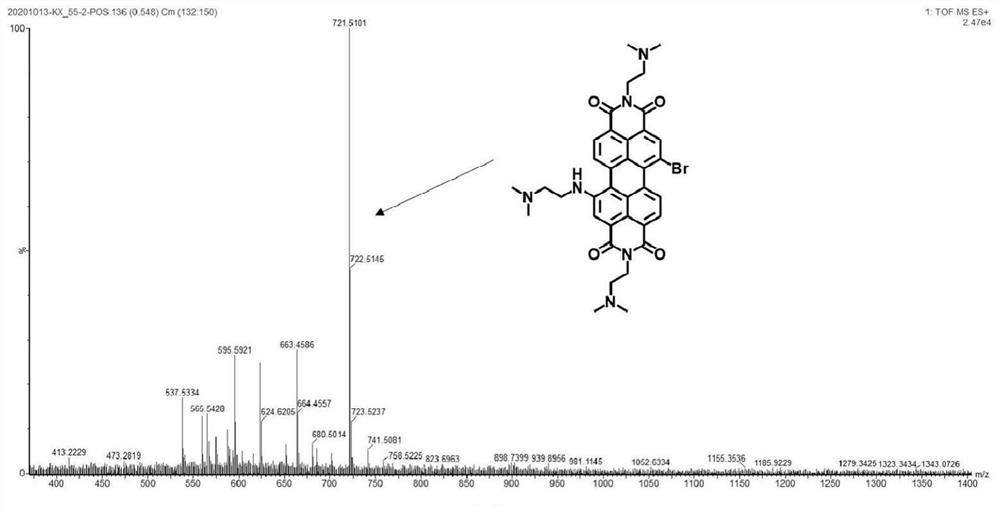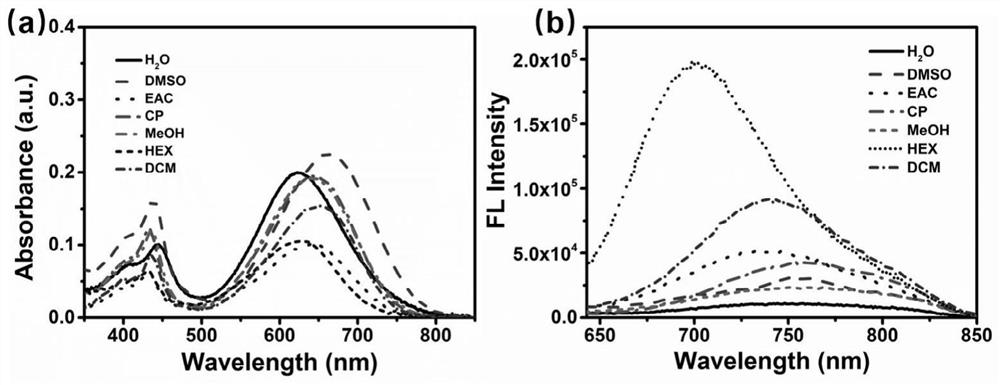Preparation method of nucleolus targeting photo-thermal reagent based on perylene bisimide and application thereof
A perylene imide and photothermal reagent technology, applied in the field of chemical synthesis of biopharmaceuticals, can solve problems such as human safety and health threats, large surgical limitations and side effects, and achieve good photothermal conversion efficiency, excellent photothermal killing effect, Good water solubility
- Summary
- Abstract
- Description
- Claims
- Application Information
AI Technical Summary
Problems solved by technology
Method used
Image
Examples
Embodiment 1
[0031] TPDI of reagent preparation: Example 1
[0032]
[0033] Step 1). The reaction flask was added 1g Compound 1, was added 50mL of concentrated sulfuric acid (H 2 SO 4 ) As solvent dissolved with stirring 2h, the reaction was further added liquid bromine 260μL, 10mg elemental iodine as a catalyst, oxygen, nitrogen protection, the reaction for 16h at 85 ℃. By N 2 The reaction flask was the residual gas remaining bromine was blown into dilute sodium hydroxide (NaOH) solution, the reaction solution was then precipitated into ice water, the precipitate then washed three times with ice, and then filtered off with suction and drying, to give compound yields 2 98%;
[0034] Step 2) and 240 mg of Compound 2 500mg of N, N- dimethylethylenediamine was added to the reaction flask was added 36mL volume ratio of 9: 6: 3 N, N- dimethylformamide (DMF), a mixed solvent of dioxane and propionic acid, N 2 Protected slowly warmed to 70 ℃, the reaction 10min, the reaction was stopped. Again on ...
Embodiment 2
[0038] Application TPDI binding agent (ctDNA, G- quadruplex) as a nucleic acid: Example 2
[0039] UV absorption and fluorescence spectra: in Example 1 TPDI photothermal agent formulated in different solvents (water, dimethyl sulfoxide, ethyl acetate, acetone, methanol, n-hexane, dichloromethane) embodiment will be 10μM test solution, the samples were tested by UV and fluorescence spectroscopy, such as image 3 Shown; in the Example 1, respectively photothermal agent 5μM, 10μM, 15μM, 20μM, 30μM of G- quadruplex ctDNA and are co-incubated overnight, and then tested for UV absorption spectra, various materials and experimental results show low after concentration of the nucleic acid binding spectrum faint red shift of the UV absorption spectrum intensity decreased, this red-shift in the G- quadruplex TPDI group and more obvious than ctDNA and TPDI group, showed bonding strength of different materials may be inconsistent nucleic acid ,like Figure 4 Indicated.
[0040]Circular Two-Colo...
Embodiment 3
[0043] Example 3: TPDI as a photothermal reagent application
[0044] Photoothermal performance test: The photosyic reagents in Example 1 were formed into aqueous solution sample of 10 μm, 30 μm, 50 μm, 100 μm, respectively, and the sample solution was irradiated with a laser having an emission wavelength of 660 nm, so that the temperature was warmed to the maximum stable temperature. A process is approximately 10 min, and the sample is made to cool to room temperature. This process is approximately 20 min, and the sample temperature is recorded in 20S interval, and the entire process is recorded by the thermal imaging, and the TPDI photothermal conversion efficiency is obtained according to the formula. About 50%, the laser power used is 1W / cm 2 ,like Figure 8 Indicated.
[0045] Photoothermal stability test: ICG is an unstable fluctine material that is often used as a control material for light thermal stability. The photothermal temperature reduction test was performed by the...
PUM
| Property | Measurement | Unit |
|---|---|---|
| particle diameter | aaaaa | aaaaa |
| particle diameter | aaaaa | aaaaa |
Abstract
Description
Claims
Application Information
 Login to View More
Login to View More - R&D
- Intellectual Property
- Life Sciences
- Materials
- Tech Scout
- Unparalleled Data Quality
- Higher Quality Content
- 60% Fewer Hallucinations
Browse by: Latest US Patents, China's latest patents, Technical Efficacy Thesaurus, Application Domain, Technology Topic, Popular Technical Reports.
© 2025 PatSnap. All rights reserved.Legal|Privacy policy|Modern Slavery Act Transparency Statement|Sitemap|About US| Contact US: help@patsnap.com



